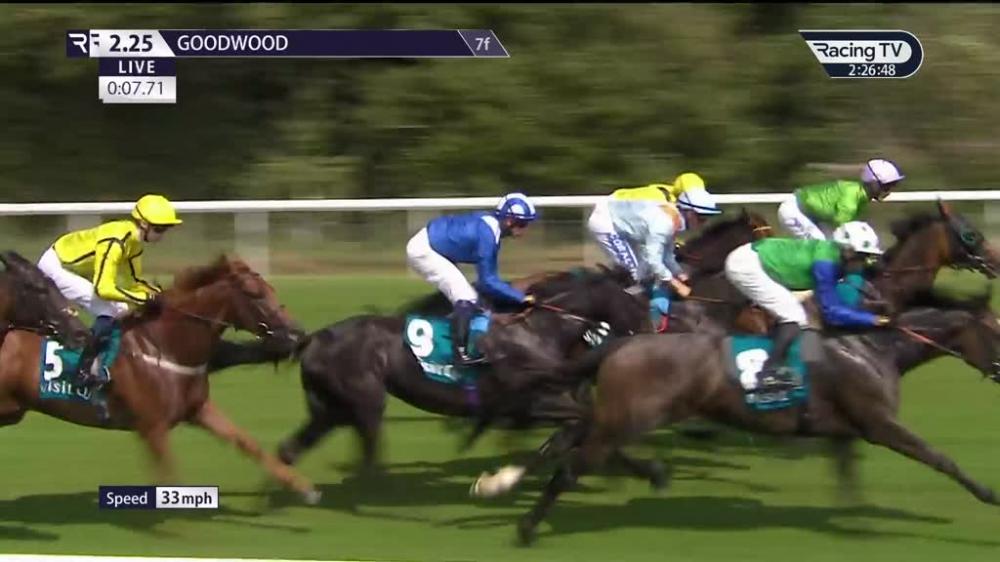Login
Free Trial

RaceiQ hints and tips for day two of Glorious Goodwood

By Andy Stephens
Last Updated: Tue 29 Jul 2025
Finding chinks in the armour of Field Of Gold is a thankless task, and you certainly will not find any when scrutinising his RaceiQ data.
His numbers all stack up and, unless a quick sequence of Group One assignments catch up with him, it is difficult to envisage the Juddmonte-owned colt being beaten in the Visit Qatar Sussex Stakes at Goodwood on Wednesday.
The bookmakers make the grey a general 2-5 to cement his status as this year’s champion miler and it’s easy to understand why they are effectively waving the white flag.
Field Of Gold showed a dazzling turn of foot when landing the Irish 2000 Guineas at The Curragh in May, and similar acceleration when bursting clear in the St James’s Palace Stakes last time. Those victories have helped erase the memory of his unfortunate defeat in the 2000 Guineas at Newmarket, which led to his then jockey, Kieren Shoemark, losing the ride on him.

Field Of Gold strides clear in the Irish 2000 Guineas (focusonracing.com)
Shoemark’s replacement Colin Keane has since kept things simple, leading as far as two furlongs from home at Royal Ascot last time. He will be a frustrated spectator on Wednesday, having picked up an untimely whip ban, but it’s doubtful his deputy, William Buick, will tinker with the formulae.
Field Of Gold was the only runner to dip under 12 seconds in the sixth furlong of the St James’s Palace Stakes, sweeping him from fifth to first, and he followed that with a race-clinching 12.02 sec seventh furlong. Nothing else got close to that, which sealed the deal.
Previously, at The Curragh, he had the distinction of being the quickest horse through each of the final four furlongs. And he was a whisker away from being swiftest through each of the final six. His penultimate furlong of 10.76 sec exhibited all his pace and power.
His peak stride in Ireland measured 7.76 metres and, at his maximum, his cadence was an impressive 2.44 strides per second. We are into the realms of a top sprinter here, which makes him so potent given his ability to stay a mile so strongly.
Whether he will be so effective over a mile and a quarter is a debate for another day.
Windlord has acted as a pacemaker for Field Of Gold in his past two starts, but has earned a breather from that role, and this time it will be the supplemented Qirat, partnered by Richard Kingscote, who will be on front-running duties.

Docklands fends off Rosallion(focusonracing.com)
It looks a logical move given that Qirat, who has an official rating of 102, is a two-time course winner who is effective over shorter. The RaceiQ data tells us he reached 20mph in just 2.01 seconds in the Victoria Cup at Ascot on his penultimate start, so he’s well qualified to tee things up for the headline act.
The French 2000 Guineas winner, Henri Matisse, chased home Field Of Gold at Royal Ascot, having stalked him into the straight. He simply did not have the gears to keep up and the fact that the sectionals reveal he was marginally quickest of the pair in the final furlong is something of an irrelevance, given what occurred immediately beforehand. He will also have a pacemaker, as he did at Ascot, which will again provide something of a sideshow.
Last month’s Queen Anne Stakes at Royal Ascot was a messy affair in which Docklands pipped Rosallion by a nose. As I’ve touched on in an earlier column, the RaceiQ sectionals reveal that in the the first four furlongs they went very slow, very slow, very slow and then slow. Furlong five was merely “par” before, finally, the tempo increased.
It turned into a dash, with the first six home all recording Finishing Speed Percentages of 108% and higher.
As a form clue for Wednesday, it seems worthless, although it was disappointing that Rosallion could not get back to winning ways, given he had salvaged what seemed lost causes in last year’s St James’s Palace Stakes and Irish 2000 Guineas.
It will be fascinating to see exactly what he can do in a truer-run race, but Field Of Gold’s digits are simply more compelling.
The one runner who is difficult to gauge through the prism of RaceiQ is Carl Spackler, who was a three-time Grade One winner in America before being switched to Australian shores.
He was only sixth in the Queen Anne, fading in the final furlong, but he was too keen for much of the race because of the dawdle they went. We will learn more about him on this occasion.

Jabaara to put record straight
One of the unluckiest losers at Goodwood last year was Jabaara, who was first past the post in the HKJC World Pool Oak Tree Stakes only to lose the race in the stewards’ room for being adjudged to have caused interference.
It could not have been a straightforward decision to deprive the Roger Varian-trained filly of the spoils as she burst to the front before hanging to her right and momentarily causing Raqiya to check. That horse rallied to finish a close second.
Twelve months later, Jabaara gets the chance to put the record straight and she will take plenty of stopping if in the same kind of form.
Typically, Jabaara was fast from the stalls last year – she has a good habit of being quickest to get from 0-20mph in her races – and after being settled in midfield from stall 10, she fired off successive 10.83sec furlongs to lead over a furlong out.

Her drift across the track cost her ground, momentum and ultimately the spoils. She had also wandered off a straight course when winning a Listed prize at Carlisle last year, so it is perhaps part of her make-up.
That need not be a problem this time, though, because Jabaara has a favourable draw in stall 4 and, if breaking with her usual zest, should this time be able to grab a position on the inside.
RaceiQ’s draw bias calculations from the past 12 years point to those drawn between 1 and 5 having a marked advantage.
Between them, they have an excess win percentage of just over 29% (per cent of rivals beaten is 55%), whereas those drawn 6-9 are minus 5.35%, and those 10-14 are minus 24.72% (per cent of rivals beaten about 44%).
Moreover, Jabarra has looked as good as ever this year, landing another Listed prize at Musselburgh on her penultimate start. That was a steadily-run race in which her early gate speed and ability to deliver successive sub 11-second furlongs in the second half of the contest was again pivotal.
I’d put a line through her below-par run at Chelmsford last time as she was drawn widest of all and, in any case, she is simply a better operator on turf. By contrast, the winner, Cloud Cover, who she meets again, has raced exclusively on artificial surfaces for the past two years and remains a maiden on grass.
Racing TV encourages responsible gambling - to find out more click here to head to our dedicated website page.
Copyright 2025 Racing TV - All Rights Reserved.
Please bet responsibly
Copyright 2025. All rights reserved




